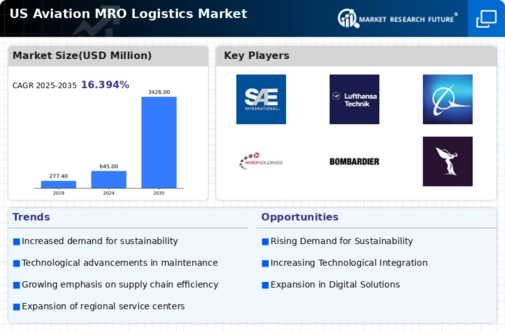Increasing Demand for Air Travel
The aviation mro-logistics market is experiencing a notable surge in demand due to the rising number of air travelers in the United States. As airlines expand their fleets to accommodate this growth, the need for maintenance, repair, and overhaul services becomes increasingly critical. According to recent data, the number of passengers traveling by air is projected to reach 1 billion annually by 2027. This escalation in air traffic necessitates a robust logistics framework to ensure aircraft are maintained efficiently and safely. Consequently, the aviation mro-logistics market is poised for growth as airlines invest in advanced logistics solutions to streamline operations and enhance service delivery.
Growth of the Cargo and Freight Sector
The expansion of the cargo and freight sector is a pivotal driver for the aviation mro-logistics market. With e-commerce and global trade on the rise, airlines are increasingly focusing on cargo operations to diversify revenue streams. This shift necessitates specialized MRO services tailored to cargo aircraft, which often have different maintenance requirements compared to passenger planes. The cargo segment is expected to grow at a CAGR of 4.5% through 2028, further emphasizing the need for efficient logistics solutions. Consequently, the aviation mro-logistics market must adapt to support this evolving landscape, ensuring that MRO services align with the unique demands of cargo operations.
Emerging Market Players and Competition
The aviation mro-logistics market is witnessing the emergence of new players, intensifying competition within the industry. These new entrants often bring innovative solutions and competitive pricing, challenging established MRO providers to enhance their service offerings. This competitive landscape encourages continuous improvement and innovation, as companies strive to differentiate themselves in a crowded market. Additionally, the presence of diverse service providers can lead to more options for airlines, potentially lowering costs and improving service quality. As competition escalates, the aviation mro-logistics market is likely to evolve, fostering an environment conducive to growth and development.
Regulatory Compliance and Safety Standards
The aviation mro-logistics market is significantly influenced by stringent regulatory compliance and safety standards imposed by aviation authorities in the United States. These regulations mandate regular maintenance and inspections of aircraft to ensure passenger safety and operational reliability. As a result, airlines and MRO providers must invest in comprehensive logistics systems to manage compliance effectively. The Federal Aviation Administration (FAA) enforces these regulations, which can lead to increased operational costs. However, adherence to these standards is essential for maintaining airworthiness and avoiding penalties, thereby driving demand for specialized logistics services within the aviation mro-logistics market.
Technological Advancements in MRO Processes
Technological advancements are reshaping the aviation mro-logistics market, enabling more efficient and effective maintenance processes. Innovations such as predictive maintenance, data analytics, and automation are being integrated into MRO operations, allowing for real-time monitoring of aircraft health. This shift not only reduces downtime but also enhances the overall efficiency of logistics operations. For instance, predictive maintenance can decrease maintenance costs by up to 30%, thereby providing a compelling incentive for airlines to adopt these technologies. As the industry continues to embrace digital transformation, the aviation mro-logistics market is likely to witness substantial growth driven by these technological enhancements.






















Leave a Comment